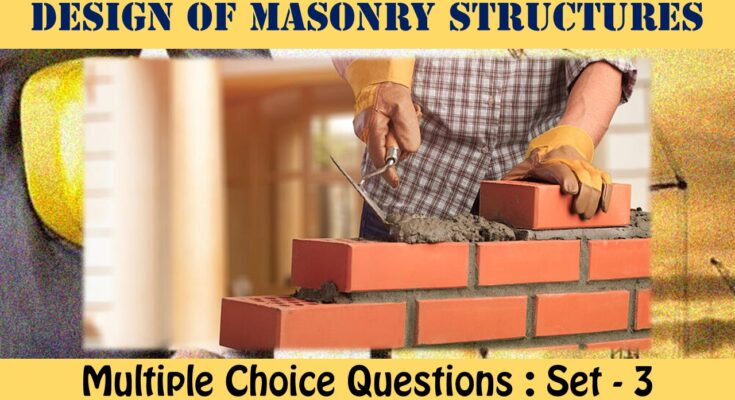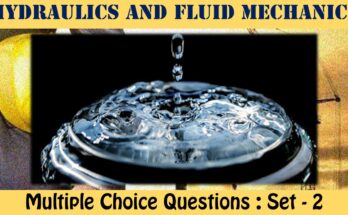MCQ Questions Civil Engineering Design of Masonry Structures
The interviewer is almost as nervous as the candidate in most interviews. You might wonder if you look confident enough, if you will hire the right person, or if you are asking the right engineering interview questions. The last question is arguably the most crucial part to worry about when you’re interviewing candidates. Other topics on Civil Engineering Multiple Choice Questions can be accessed
MCQ Questions Civil Engineering Design of Masonry Structures - Set - 3
Question 1:
Consider the following statements :
The use of relatively weak mortar
1. will accommodate movements due to loads and, cracking if any, and will be distributed as thin hair cracks which are less noticeable or harmful.
2. will result in reduction of stresses due to differential expansion of masonry units.
Of these statements
a) 1 alone is correct
b) 2 alone is correct
c) both 1 and 2 are correct
d) neither 1 nor 2 is correct
Correct Answer – (C)
Question 2 :
Assertion A : Limiting value of slenderness ratio for a column is less than that of a wall.
Reason R : A column can buckle around either of the two horizontal axes while a wall can buckle around only one axis. Select your answer according to the codes given below:
a) Both A and R are true and R is the correct explanation of A.
b) Both A and R are true but R is not the correct explanation of A.
c) A is true but R is false.
d) A is false but R is true.
Correct Answer – (A)
Question 3 :
Consider the following statements regarding bands to be provided for strengthening masonry work in masonry buildings constructed in zone III, IV and V. (i) Lintel band is provided at lintel level on partition walls, (ii) Gable band is provided at top of gable masonry below the purlins, (iii) The bands shall be to full width of the wall and not less than 7.5 cm in depth, (iv) The bands shall be made of reinforced concrete only. Of these statements, the correct statements are
a) (i) and (ii)
b) (i) and (iii)
c) (ii) and (iv)
d) (ii) and (iii)
Correct Answer – (D)
Question 4 :
For earthquake resistant masonry buildings, the vertical distance between openings one above the other in a load bearing wall shall not be less than
a) 50 cm
b) 60 cm
c) 75 cm
d) 100 cm
Correct Answer – (B)
Question 5 :
Rich cement mortars are more liable to cracking as compared to lean mortars because rich mortars have
a) high shrinkage
b) less strength
c) both (a) and (b)
d) none of above
Correct Answer – (A)
MCQ Questions Civil Engineering Design of Masonry Structures
Question 6:
Consider the following statements regarding provision of chases in masonry,
(i) No chase should be permitted in a half brick load-bearing wall,
(ii) Vertical chases should not be closer than 2 m in any stretch of a wall,
(iii) Chases should be provided near to bearings of beams and lintels. Of these statements
a) (i) and (ii) are correct
b) (i) and (iii) are correct
c) (ii) and (iii) are correct
d) (i), (ii) and (iii) are correct
Correct Answer – (A)
Question 7:
In a cavity wall, both leaves of which are load bearing, the effective thickness is taken as
a) sum of thickness of both leaves
b) two-third of the sum of thickness of both the leaves
c) actual thickness of the stronger leaf
d) larger of (b) and (c)
Correct Answer – (D)
Question 8:
For earthquake resistant masonry buildings, where seismic coefficient is less than 0.08, the horizontal distance between two openings shall not be less than
a) Vt x height of shorter opening
b) Vt x height of longer opening
c) Ax height of shorter opening
d) Vi x height of longer opening
Correct Answer – (A)
Question 9:
Cement mortars richer than 1 : 3 are not used in masonry because
(i) there is no gain in strength of
masonry (ii) there is high shrinkage (iii) they are prone to segregation Of these statements
a) Only (ii) is correct
b) (i) and (ii) are correct
c) (ii) and (iii) are correct
d) (i), (ii) and (iii) are correct
Correct Answer – (B)
Question 10:
Minimum compressive strength in N/mm2 for H1 type mortar used for masonry is
a) 3
b) 5
c) 7.5
d) 10
Correct Answer – (D)
- NCERT Solutions Class 12 Mathematics RD Sharma Sets : Exercise 1.1
- NCERT Solutions Class 12 Mathematics RD Sharma Sets : Exercise 1.2
- NCERT Solutions Class 12 Mathematics RD Sharma Sets : Exercise 1.3
- NCERT Solutions Class 12 Mathematics RD Sharma Sets : Exercise 1.4
- NCERT Solutions Class 12 Mathematics RD Sharma Trigonometric Functions : Exercise – 5.1
- NCERT Solutions Class 12 Mathematics RD Sharma Trigonometric Functions : Exercise – 5.2
- NCERT Solutions Class 12 Mathematics RD Sharma Trigonometric Functions : Exercise – 5.3
- NCERT Solutions Class 12 Mathematics RD Sharma Quadratic Equations : Exercise – 14.1
- NCERT Solutions Class 12 Mathematics RD Sharma Quadratic Equations : Exercise – 14.2
- NCERT Solutions Class 12 Mathematics RD Sharma Linear Inequations : Exercise – 15.1
- NCERT Solutions Class 12 Mathematics RD Sharma Linear Inequations : Exercise – 15.2
- NCERT Solutions Class 12 Mathematics RD Sharma Linear Inequations : Exercise – 15.3
- NCERT Solutions Class 12 Mathematics RD Sharma Linear Inequations : Exercise – 15.4
- NCERT Solutions Class 12 Mathematics RD Sharma Linear Inequations : Exercise – 15.5
- NCERT Solutions Class 12 Mathematics RD Sharma Linear Inequations : Exercise – 15.6
Multiple Choice Questions for Competitive Exams
- Multiple Choice Questions Class 12 Chemistry The Solid State
Set -1 Set -2 Set -3 Set -4 Set -5 - MCQ Questions Class 12 Solutions With Answers
Set -1 Set -2 Set -3 Set -4 Set -5 - MCQ Questions Class 12 Electrochemistry With Answers
Set -1 Set -2 Set -3 Set -4 Set -5 - MCQ Questions Class 12 Chemical Kinetics With Answers
Set -1 Set -2 Set -3 Set -4 Set -5 - MCQ Questions Class 12 Surface Chemistry With Answers
Set -1 Set -2 Set -3 Set -4 Set -5 - MCQ Questions Class 12 General Principles and Processes of Isolation of Elements With Answers
Set -1 Set -2 Set -3 Set -4 Set -5




